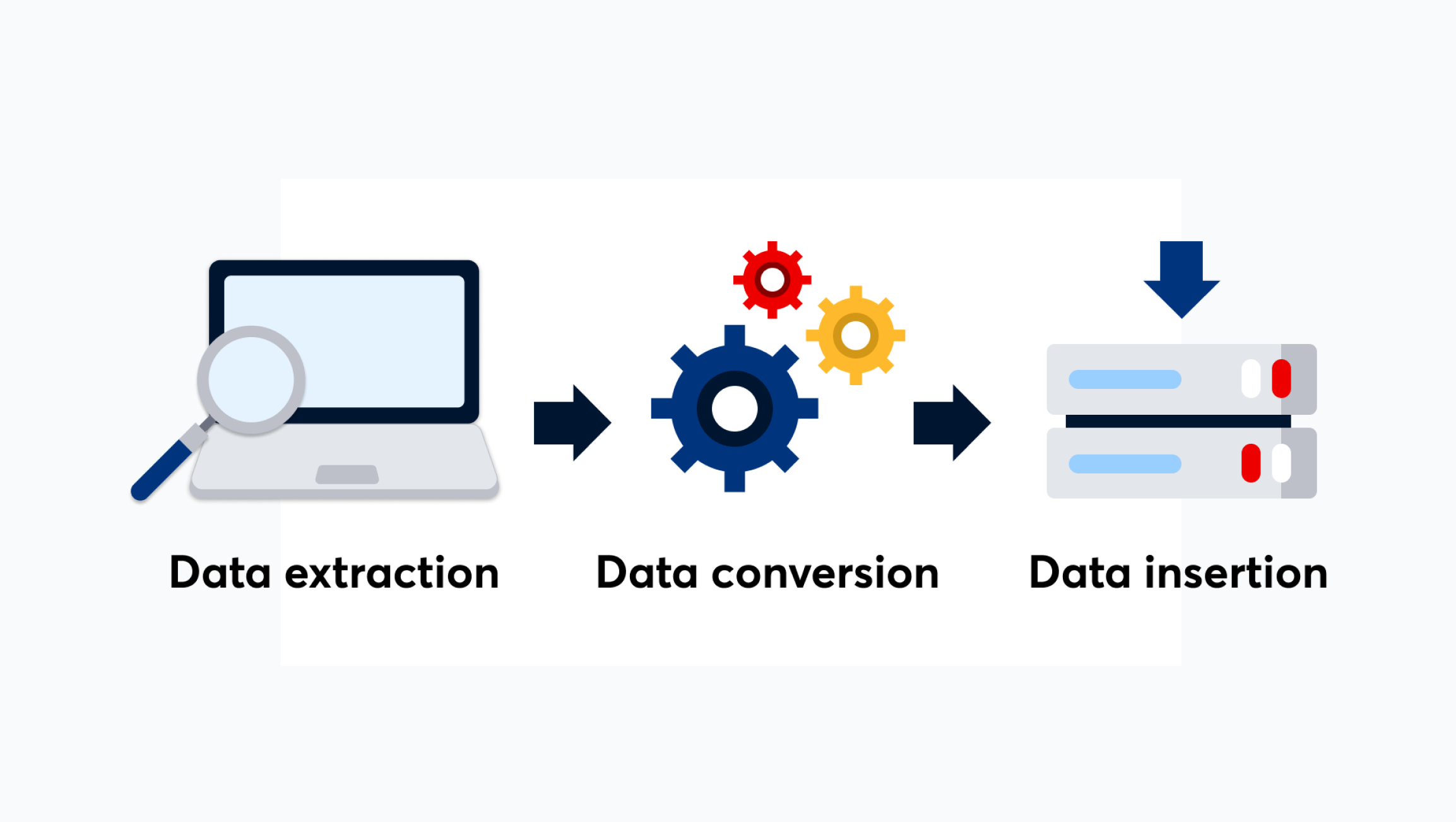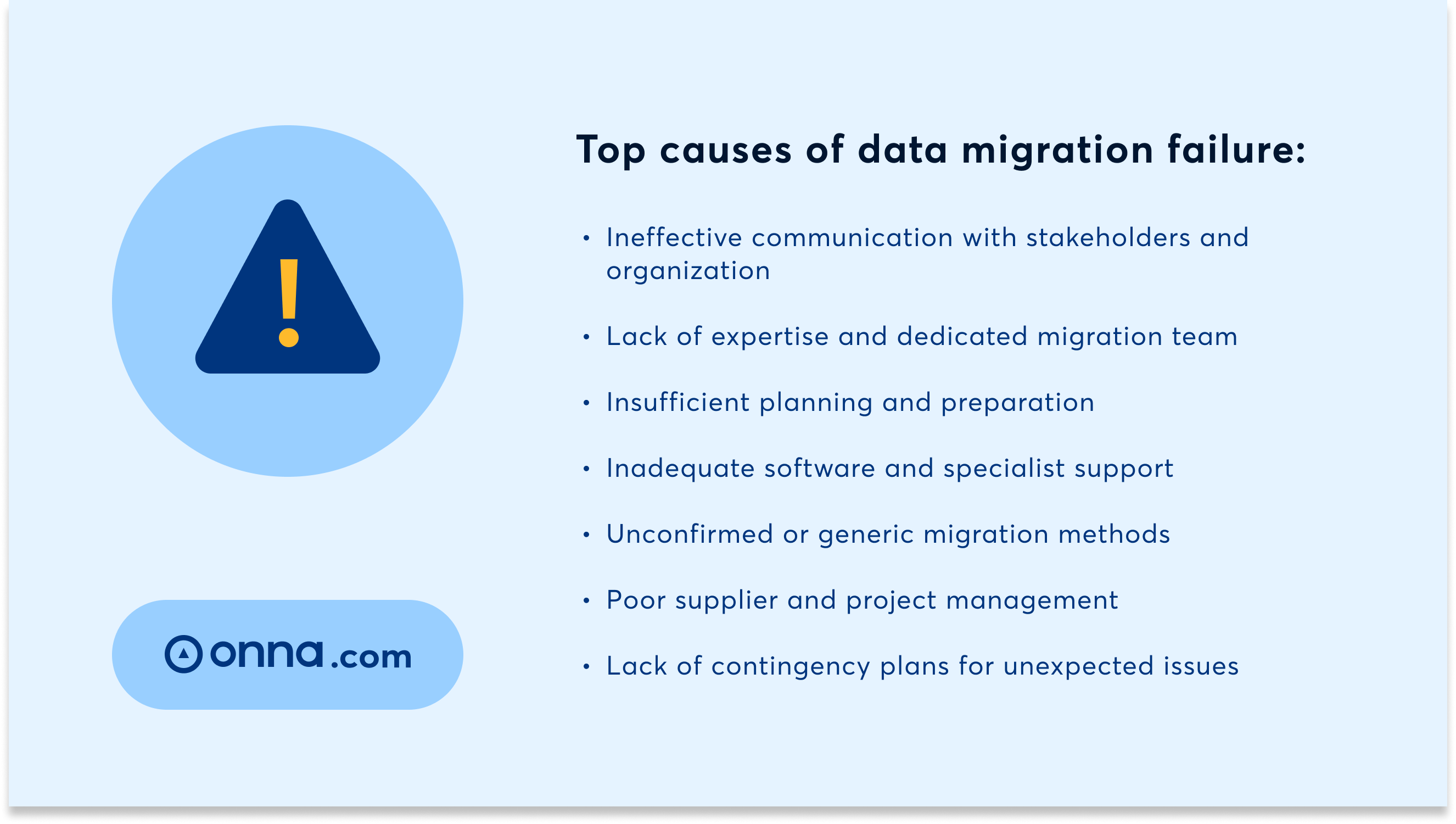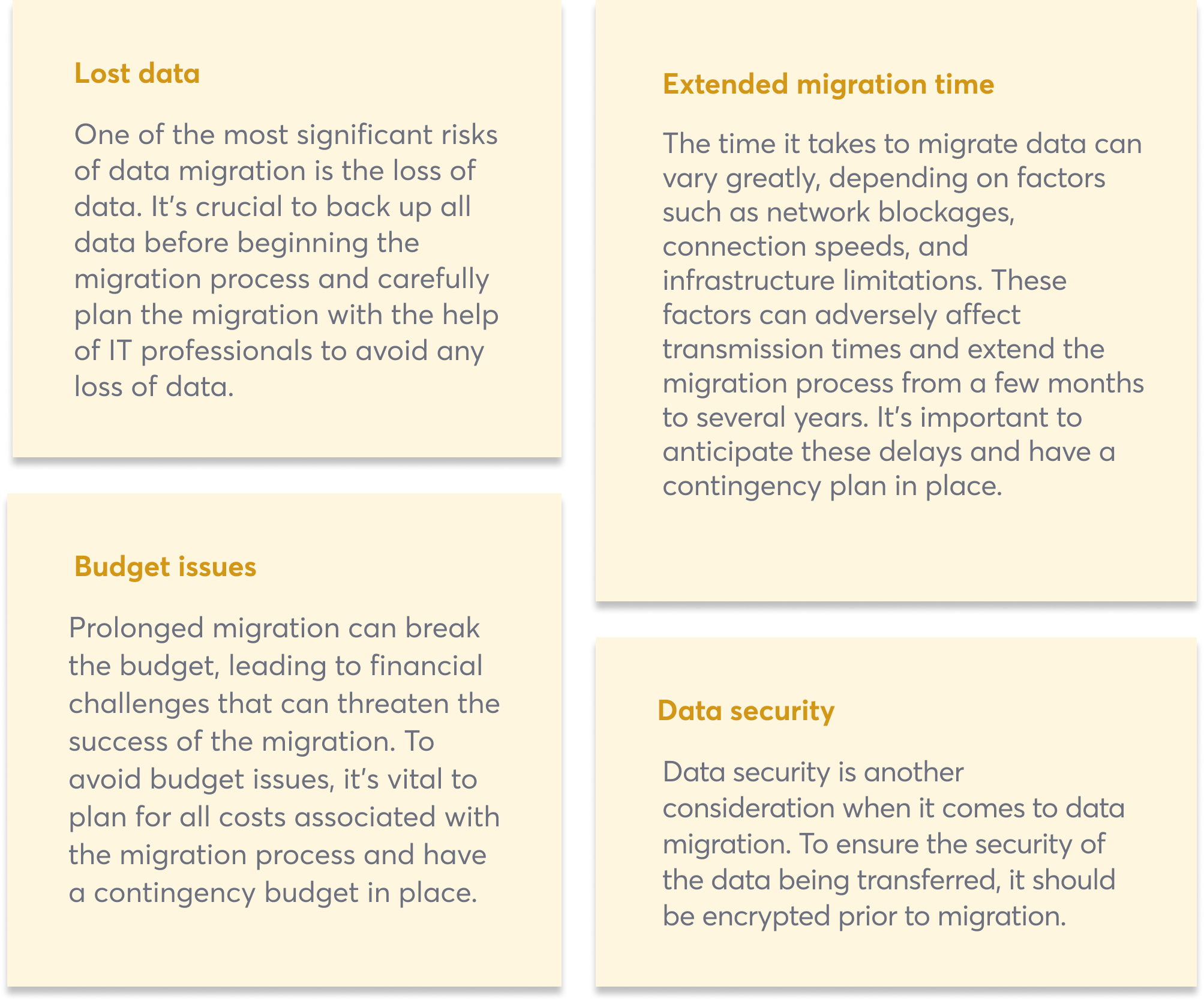Data migration basics: A comprehensive guide

Table of Contents
- What is data migration?
- Why is a data migration strategy so important?
- Data migration vs. data conversion vs. data integration
- Main types of data migration
- 3 Data migration strategies
- The data migration process
- How to create a data migration plan
- Common data migration challenges
- Data migration best practices
- Data migration risks: Common pitfalls to avoid
- About Onna’s Data Migration services
Today’s businesses rely heavily on information to fuel growth, make informed decisions, and stay ahead of the competition. As organizations evolve and adopt new technologies, they often need to transfer data from one system or platform to another. Enter the realm of data migration – a critical but complex process that requires careful planning, strategizing, and execution.
In this comprehensive guide, we’ll delve into the various aspects of data migration, from understanding its importance and types to exploring strategies, processes, challenges, and best practices. Whether you’re an IT professional or a decision-maker seeking to gain valuable insights on data migration, by the end of this guide, you'll have a solid understanding of the landscape and be well-prepared to tackle future migration projects.
Let’s get started.
What is data migration?
Data migration is the process of moving data from one location to another, from one format to another, or from one application to another. Companies often undertake this process to modernize or optimize their operations by introducing new systems or consolidating old ones. One example of this is when companies move from on-premises infrastructure and applications to cloud-based storage and applications.
The primary objective of data migration is to ensure that data is accurately and securely transferred from the source system to the destination system while preserving its integrity and usability. This involves a series of steps, including data profiling, mapping, cleansing, validation, and testing, each aimed at ensuring that the data is properly transferred and meets the destination system's requirements.
When executed effectively, data migration can significantly enhance a company's operations, boost productivity, and decrease expenses by consolidating data storage systems, phasing out legacy systems, and minimizing the reliance on manual data entry or updates. Nonetheless, meticulous planning and execution are paramount to prevent data loss or other complications that may adversely affect the organization.

Why is a data migration strategy so important?
Data migration is often part of a larger project, such as replacing legacy software, expanding storage systems, or transitioning to a centralized database to eliminate data silos. The primary objective is typically to boost performance and competitiveness while reducing operational expenses. However, it’s crucial to get it right; otherwise, an unsuccessful migration may lead to inaccurate data riddled with redundancies and uncertainties, ultimately hampering business operations.
To ensure a successful migration, it’s important to have a well-defined strategy that takes into account several factors. These include:

A comprehensive data migration strategy can prevent migration failures that can cause missed deadlines, blown budgets, and more significant issues for businesses. By taking the necessary steps and planning adequately, companies can ensure a (mostly) headache-free migration, leading to better operations, increased efficiency, and reduced costs.
Data migration vs. data conversion vs. data integration
In the world of data management, it’s easy to get confused between the terms data migration, data conversion, and data integration as they’re often used interchangeably. However, it's important to understand the differences between these terms to ensure the right process is selected for the data at hand.
Data migration refers to moving data between locations, formats, or systems. This process involves profiling, cleansing, and validating the data, as well as ongoing data quality assurance. Its primary goal is to move data from the source to the new system accurately and efficiently.
On the other hand, data conversion is typically the first step in data migration, which involves transforming data from one format to another. It is necessary when moving data from a legacy application to an upgraded version of the same application or a new application with a different structure. Data conversion requires extracting data from the source, modifying it, and then loading it into the new system based on specific requirements.

Data integration, another term that is sometimes confused with data migration, is the process of combining data residing at different sources to provide users with a unified view of all the data. This process includes steps such as cleansing, ETL mapping, and transformation. Data integration is essential for data analytics because it helps combine data from various sources to provide better insights.
Main types of data migration
Data migration is typically performed using one of the following methods:
 Email migration
Email migration
Email migration is the process of moving one or multiple email messages from one email client to another. Similar to email migration, mailbox migration involves transferring emails, appointments, contacts, or tasks. Typically, users perform email migration when they switch from their current email client to a new one.
 Document migration
Document migration
Legacy repositories often store critical documents that are essential to the operation of an organization, and migrating these documents may be mandatory. However, before migrating every document and its corresponding metadata, consider archiving some or all documents. Archiving is generally less costly than ensuring that every document is correctly mapped and suitable for migration.
 Database migration
Database migration
Database migration involves moving data from one database management system (DBMS) to another or upgrading from the current to the latest version of a DBMS. This process can be particularly challenging if the source and target systems employ different data structures.
 Social media migration
Social media migration
Social media migration involves transferring an online community from one platform to another. Although the idea of moving an established community from Facebook, LinkedIn, or Yahoo to a new platform may be daunting, it could be the change needed to improve and grow the community.
 Cloud migration
Cloud migration
Cloud migration involves moving data or applications from an on-premises location to the cloud or from one cloud environment to another. This type of migration is on the rise, and according to Gartner, enterprise IT spending is expected to overtake spending on traditional IT by 2025.
 Legacy system migration
Legacy system migration
A legacy application refers to a software program or application that companies have relied on for years, but has become outdated or obsolete. To meet the needs of today’s businesses, a legacy system migration involves moving these outdated programs or applications to an up-to-date environment. However, challenges may arise, such as poor data quality, lengthy processing times, and a general lack of expertise in legacy data migration.
To ensure a successful migration, it’s crucial to have a solid plan. While moving essential or sensitive data and retiring legacy systems can seem daunting, remember that you don't have to reinvent the wheel.
3 Data migration strategies
When it comes to migrating data, there are several strategies available to organizations, each with its own advantages and disadvantages.
Here are the three main approaches:
-
Big bang data migration
The Big Bang approach involves moving all data in a single operation from the current environment to the target environment. It is a fast and less complex method, making it less costly. However, it requires all systems to be down and unavailable for users during the migration, which can cause disruption. Therefore, it is best used when users are not expected to use the system. The risk of an expensive failure can offset the advantages of a big bang migration, making it more suitable for small companies with smaller amounts of data or operations. -
Phased migration (Trickle-down migration)
The phased migration approach is a trickle-down technique that reduces the migration process into sub-processes where data is transferred in small increments. This approach enables the old system to remain operational and run parallel with the migration. The iterative nature of the process can make it more complicated and prolonged, but there is no downtime in the live system, making it less susceptible to errors and unexpected failures. This approach is best for big data organizations that cannot afford any system downtime. -
Parallel data migration
In a parallel migration, the new system is run alongside the legacy system until all the bugs are worked out, and the team ensures that business processes run correctly. This approach offers the lowest level of risk, as the business is not disrupted during the migration, and any issues can be addressed entirely before the legacy system is disabled. However, running two systems alongside each other can be expensive, and if it takes an extended period of time to rectify any problems, costs can skyrocket.
Choosing the right migration strategy for your organization will depend on factors such as data size, complexity, and expected downtime. Consider the advantages and disadvantages of each approach to make an informed decision that aligns with your organization's needs.
The data migration process
To ensure an efficient and successful data migration project, it’s essential to plan well and prioritize a seamless and efficient process that does not go over budget or result in a lengthy migration. The process involves three primary steps:

Regardless of the approach taken, a data migration project typically goes through the same key phases, including:
-
Pre-migration planning
The pre-migration planning stage is crucial for establishing budgets, timelines, and deadlines. Evaluating existing data sets for stability, analyzing the source and target system, and setting standards to detect potential issues are also critical during this phase. Decisions regarding which migration approach to use are typically made at this stage as well. -
Data inspection
During the data inspection phase, the data is scrutinized for quality, irregularities, or potential conflicts and duplications. Software application tools may be used to clean the data if necessary. -
Data backup
Data backup involves backing up all data to be migrated to protect against data loss during the migration process. This sensible measure helps eliminate the risk of data loss. -
Migration process
During the migration process stage, the migration testing techniques, acceptance standards, and responsibilities of the personnel involved in the migration are specified. An extract, transform, load (ETL) developer, data engineer, system analyst, and business analyst may be hired to take charge of the process. -
Execution
The execution of the migration process is initiated, and the ETL processes go live at this stage (extraction, transformation, and loading). The process duration will depend on the volume of data involved and the migration approach used. -
Validation
After the migration process is complete, it must be validated to ensure it has been executed according to the set guidelines, and data migrated to the new environment is complete and viable for business use. -
Decommission and monitor
In the post-migration step, once the new system has been fully tested and is running smoothly, it’s time to decommission the old system. This may involve shutting down servers, archiving data, and deleting files or databases. Additionally, even after the post-migration testing is complete, it's important to continue monitoring the new system to identify any issues or potential problems. This may involve setting up alerts or notifications to quickly identify any issues, as well as conducting regular performance checks to ensure that the system is running smoothly.

Many organizations see data migration as a necessary evil rather than an essential process that will add value to their business. However, reframing migration as a vital innovation project worthy of serious consideration can help ensure an efficient, cost-effective, and successful project.
How to create a data migration plan
Data migration can significantly impact a business's operations. Administrators must balance data integrity, cost containment, and minimal disruption to business processes when planning and executing a migration project. One of the most critical factors in achieving a successful migration is developing a detailed plan that accounts for potential risks and challenges.
The following are some key phases to consider when planning a data migration project:

A detailed migration plan is the first step in a successful data migration project. By selecting, preparing, extracting, transforming, and transferring data with the proper form and quality, you can ensure a smooth transition with minimal impact on your business. Remember to prioritize data integrity, cost containment, and minimal disruption when developing your plan, and seek support from experienced professionals to ensure a successful migration.
Common data migration challenges
Despite the fact that organizations have been performing data migrations for decades, they still encounter various challenges during the process. Below are some of the most common data migration challenges that organizations face:
-
Failure to communicate with key stakeholders. When conducting a data migration, communicating with all relevant stakeholders is non-negotiable. This involves explaining the necessity of the project and the impact it will have on them before the migration begins. Failure to do so can lead to disruptions in the migration timeline.
-
Failure to communicate with the organization. In addition to communicating with key stakeholders, it’s crucial to keep everyone informed of the migration's progress by providing weekly status reports, especially if the migration is running off track. Consistent communication builds trust with all parties affected by the migration.
-
Absence of authority. It’s important to understand who has the right to create, endorse, revise, or delete data from the source system. This information should be documented as part of the project plan to avoid confusion.
-
Lack of expertise. Although data migration may seem like a straightforward task, it is highly complex. A dedicated migration team with experienced specialists will streamline the process and help ensure its success.
-
Insufficient planning. Planning a large event can take up to 300 hours, yet IT teams may only spend a small fraction of that time planning a data migration. While hours spent planning doesn't guarantee success, a solid migration plan can save time and prevent problems down the line.
-
Insufficient data prep software and skills. For a large migration with millions of records or hundreds of tables, investing in quality software and hiring a specialist firm to assist with the project can help ensure success.
-
Looking for perfection. While it’s necessary to have well-defined design criteria, the quest for perfection can sometimes erode progress. It is crucial to continue making progress while the implementation team sorts out design criteria, as data validation will occur later in the project.
-
Unconfirmed migration method. Conduct research to ensure that the data movement process you have selected has worked well for other organizations like yours. Resist the temptation to accept a generic procedure (this is very important).
-
Lack of supplier and project management. Vendors and projects need to be managed. Make sure you have the time and resources to manage the project and any related suppliers.
-
Make a contingency plan. Even with the technology and capabilities of data management tools available today, dependent datasets can still fall through the cracks. Build in a contingency plan for such scenarios so your delivery date isn't compromised.

Data migration best practices
Whether you’re migrating data to a new on-premises solution or a public cloud environment, a clear and comprehensive approach is required for a smooth, efficient, and successful migration. Here are some best practices to consider for your next migration project:
-
Develop a comprehensive strategy. Determine the tools that will be used for the migration, outline the migration requirements, and create a solution that aligns with your organization's goals.
-
Assemble a dedicated team. Assign roles, request necessary resources, and begin planning the project to ensure the team is well-equipped to handle the migration.
-
Gather necessary details. Conduct a thorough assessment of your current environment, identify critical risk factors and dependencies, and develop a workable timeline for the migration.
-
Document the process. Assess network requirements and create a service workbook that includes the migration strategy and policies, a transition plan, a pilot (test) plan, functional and application test plans, and remediation plans.
-
Initiate the migration. Utilize the tools according to the design documentation, create baseline copies of the data, perform cutover and post-cutover activities, triage and remediate as needed, verify that all storage, application, and network environments are ready, and validate the migrated data.
-
Close out the migration. Deliver all documentation and knowledge transfer, share best practices with the IT team, provide documentation that describes how the migration was accomplished, and confirm that all project requirements have been met.
By implementing these best practices, you can reduce the risk of errors, accelerate the migration process, and increase the likelihood of a successful data migration. Remember it’s important to create a repeatable approach that utilizes tools and procedures to ensure consistency in execution and a positive outcome.
Data migration risks: Common pitfalls to avoid
When it comes to migrating data, there are several risks that organizations should be aware of. Let's take a closer look at these risks and how to avoid them:

Despite these risks, data migration provides organizations with numerous benefits. By taking the time to clean and improve the quality of the data before the migration process, organizations can avoid poor-quality data that may cause additional problems. Therefore, migration should be seen as an opportunity to improve data quality and streamline processes, rather than just a necessary task to move data from one platform to another.
About Onna’s Data Migration services
Connect. Find. Act.
Whether you're looking to dismantle data silos, cut operational spending, adopt new technology, comply with regulatory requirements, or tackle other challenges, Onna's Data Migration services offer a comprehensive and streamlined solution for managing and transferring enterprise data.
On average, data teams devote 57 percent of their time to data migration and maintenance. When considering the time invested in these tasks against the estimated annual data expenses, such outdated methods can significantly inflate costs for businesses.
Leveraging AI and machine learning, Onna automatically classifies and categorizes information, streamlining data organization and eliminating redundancies. By centralizing and rendering data easily searchable, Onna enhances data quality, accessibility, and security. This streamlined approach fosters seamless integration, robust governance, and sophisticated analytical capabilities. As a result, businesses can tap into the full potential of their existing data, empowering data-driven decision-making and driving improved outcomes.
To learn more about Onna’s Data Migration services, get in touch here.
 eDiscovery
eDiscovery Collections
Collections Processing
Processing Early Case Assessment
Early Case Assessment Information Governance
Information Governance Data Migration
Data Migration Data Archiving
Data Archiving Platform Services
Platform Services Connectors
Connectors Platform API
Platform API Pricing Plans
Pricing Plans Professional Services
Professional Services Technical Support
Technical Support Partnerships
Partnerships About us
About us Careers
Careers Newsroom
Newsroom Reveal
Reveal Logikcull by Reveal
Logikcull by Reveal Events
Events Webinars
Webinars OnnAcademy
OnnAcademy Blog
Blog Content Library
Content Library Trust Center
Trust Center Developer Hub
Developer Hub